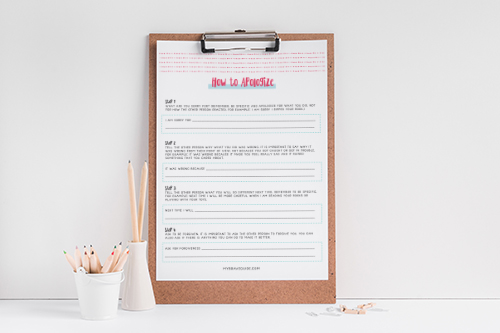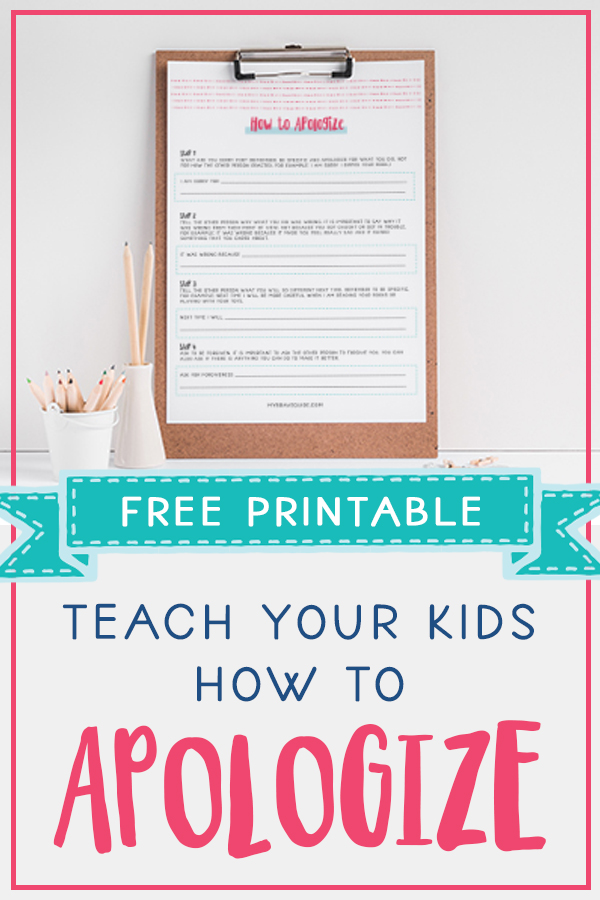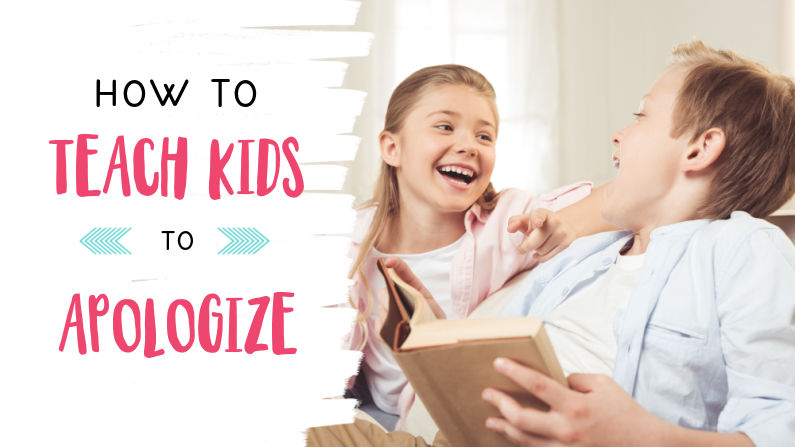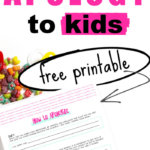Teaching Kids How to Apologize
If you are wondering how to teach kids to apologize, you are probably already aware of how important a good apology is. Apologizing can be the most important factor when it comes to resolving sibling rivalry. Learning to apologize also helps children learn to accept personal responsibility and develop empathy.
This article may contain affiliate links.
Why Teaching Kids to Apologize is Important
When an apology is done right it expresses both personal responsibility as well as empathy for the other person. Both empathy and accepting responsibility are necessary skills for relationships both between kids as well as into adulthood.
When children learn to recognize and express personal responsibility, it helps them become more self-aware. Developing this skill will help your child throughout their life with their siblings, their friends, their future co-workers, and future partners.
Empathy is similarly important. Learning to understand another person’s feelings and point of view can be challenging.
Developmentally, children need a lot of practice, guidance, and modeling to develop this ability.
How to Express Personal Responsibility through an Apology
We have all received apologies that didn’t include the person taking responsibility. Something like: “I’m sorry you feel like I was being mean but…”
This type of apology can actually be more damaging than helpful. It leaves the receiver feeling blamed or shamed and likely more mad, upset, or hurt than they were to start with.
Instead, apologies should include a statement of what the wrong-doing was. For example, “I am sorry that I broke your Legos.”
Teaching our kids to name what they did that made another person mad, upset, or hurt (when they actually did something wrong) is important. The best way for kids to learn this is for parents and adults to model this behavior.
That being said, we will also go over a 4 step approach to teaching kids (and adults) how to apologize. This method works really well for kids and is also a great form for you to use when you need to model apologizing well to your kids.
Expressing Empathy Through an Apology
The other really important aspect of apologizing is expressing empathy.
Empathy is understanding the world as another person sees it. It is understanding and recognizing someone else’s emotions and feelings.
To express empathy through an apology our kids need to become aware of what other people are feeling. This becomes developmentally possible as children grow older.
For example, a three-year-old is able to recognize very simple emotions such as mad or sad. A 10-year-old should be able to recognize many emotions and nuances of emotions such as embarrassment, jealousy, and fear.
So, from a young age, if parents focus on developing their child’s awareness of emotions, it will help them learn to be empathetic.
The younger a child is, the more guidance and assistance they will need in order to recognize, name, and understand emotions. The first step in learning to do this is naming the emotions that the child personally feels.
A great way to train your child to recognize emotions is to name them as often as possible. When your child is frustrated, say something like, “I see that you are mad right now because your face is scrunched up and your fists are clenched.”
Similarly, work on naming your own emotions around your children from a young age. For example, “I am feeling so happy right now, see how big my smile is?”
As your child grows older, you can transition to asking them to name their own emotions. And then, eventually, make the leap to naming other people’s emotions. (This starts becoming possible for kids around 8-10 years old.)
How to Teach Kids to Apologize in 4 Steps
I like to teach kids to apologize using this worksheet. The printable page gives them a tangible way to work through the 4 steps.
Having children use this worksheet also helps you, as a parent or caring adult, work through the steps with them, and reflect on whether they are effectively expressing personal responsibility and empathy.
You can download a free copy of this worksheet in the Parenting Resource Library.
Step 1: State What You Have Done Wrong
The first step in an apology is to state the wrongdoing.
I find it helpful to let kids know that stating wrongdoing doesn’t necessarily mean that they did something on purpose.
For example, a child may have accidentally broken a sibling’s toy. Saying, “I am sorry for breaking your toy” doesn’t mean they did it on purpose or that they were/are bad.
This message can be particularly important for kids who tend to have a higher sense of guilt, shame, and/or low self-esteem.
The goal is never to evoke shame in the wrong-doer. The goal is to develop personal responsibility with empathy.
If this concept of shame vs. empathy is new to you or you want to learn more, I would highly recommend listening to this talk by Brene Brown titled: “The Gifts of Imperfect Parenting.” You can listen to this with a free trial subscription to Audible.
It is also important in this step to guide your child to being specific and using “I” statements. For example:
Correct: I am sorry I broke your Lego
Wrong: I am sorry you left your Lego on the floor and I tripped over it.
Step 2: Express Why the Action was Wrong or Hurtful (empathy)
Next, you will want to teach your child to state why what they did was wrong or hurtful.
Again, the focus should be on personal responsibility rather than blame or shame. For example:
Correct: Even though it was an accident, I know that lego set was your favorite and I should have been being more careful around it.
Wrong: If you hadn’t left your Lego on the floor I wouldn’t have gotten hurt and broken it.
Correct: Breaking your Lego was wrong because it is one of your favorite toys.
Wrong: Breaking your Lego was wrong because it got me in trouble and now I lost one of my toys.
Step 3: Tell the Other Person What You Will Do Differently Next Time
This step is very important in developing personal responsibility. If your child is able to think through the situation and come up with an idea for what they could do differently, it helps them understand that they hold responsibility for their actions.
Again, with this step, it is important to emphasize being specific. For example:
Correct: Next time I will move your Lego to a safe place if I am playing near it so that I don’t accidentally break it.
Wrong: Next time I won’t break it.
Step 4: Ask for Forgiveness
Finally, teach your children to ask for forgiveness.
The best way to teach kids about forgiveness is to be willing to model it yourself.
If you make a mistake or do something that hurts your child, be willing to apologize using these steps. And, most importantly, specifically, ask for forgiveness.
Modeling asking for forgiveness helps kids learn that it is normal and shows strength and love.
Often our culture sends an underlying message (especially to boys) that apologizing, asking for forgiveness, and/or accepting personal responsibility is a sign of weakness.
As a parent, you can combat that message by modeling loving, empathetic apologies as often as possible.
One final lesson that goes along with asking for forgiveness is asking if there is anything you can do to make it better. Sometimes, asking if there is anything to do to make the situation better will need to be done before asking for forgiveness.
Again, teaching our kids to ask and be open to helping fix or solve the situation develops empathy. It teaches them to be aware of others’ feelings, thoughts, and needs.
Teaching Kids to Apologize Takes Practice
Learning to apologize in a way that accepts personal responsibility and shows empathy takes practice. I like to use the How to Apologize worksheet with my kids using sample scenarios.
This is a great activity to do during a family meeting. Teaching and practicing apologizing in this type of fun, relaxed environment can be a great way to let kids know that apologizing is important and helps them become a better sibling, son or daughter, friend, and person!


